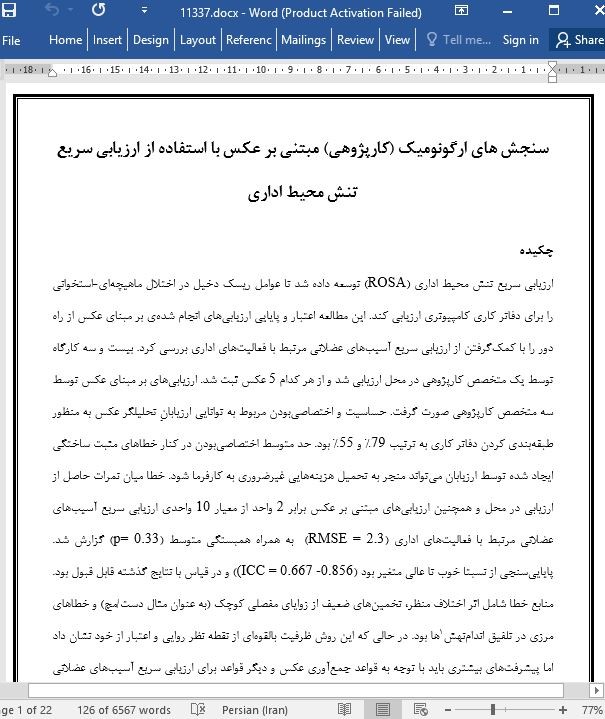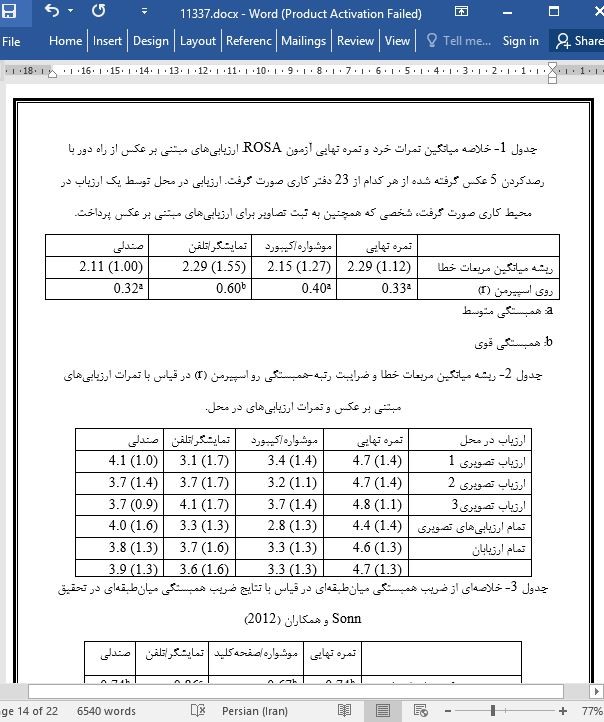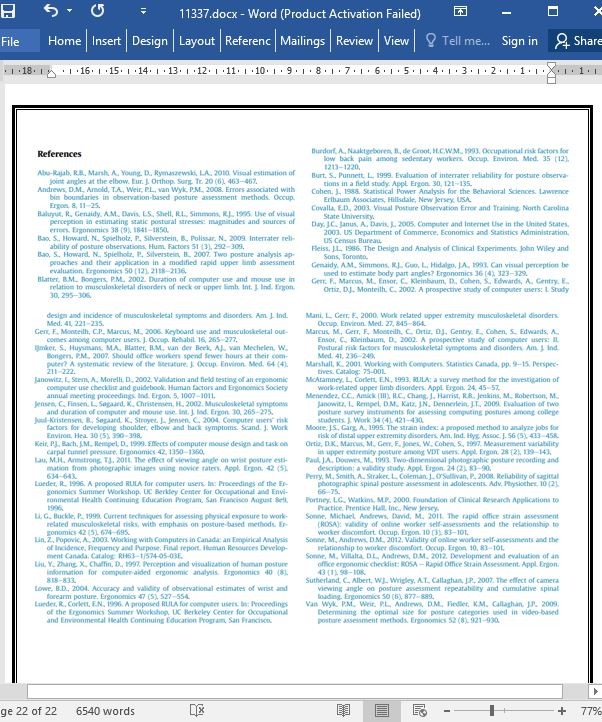
سنجش های ارگونومیک (کارپژوهی) مبتنی بر عکس با استفاده از ارزیابی سریع تنش محیط اداری
چکیده
ارزیابی سریع تنش محیط اداری (ROSA) توسعه داده شد تا عوامل ریسک دخیل در اختلال ماهیچهای-استخوانی را برای دفاتر کاری کامپیوتری ارزیابی کند. این مطالعه اعتبار و پایایی ارزیابیهای انجام شدهی بر مبنای عکس از راه دور را با کمکگرفتن از ارزیابی سریع آسیبهای عضلانی مرتبط با فعالیتهای اداری بررسی کرد. بیست و سه کارگاه توسط یک متخصص کارپژوهی در محل ارزیابی شد و از هر کدام 5 عکس ثبت شد. ارزیابیهای بر مبنای عکس توسط سه متخصص کارپژوهی صورت گرفت. حساسیت و اختصاصیبودن مربوط به توانایی ارزیابانِ تحلیلگر عکس به منظور طبقهبندی کردن دفاتر کاری به ترتیب 79% و 55% بود. حد متوسط اختصاصیبودن در کنار خطاهای مثبت ساختگی ایجاد شده توسط ارزیابان میتواند منجر به تحمیل هزینههایی غیرضروری به کارفرما شود. خطا میان نمرات حاصل از ارزیابی در محل و همچنین ارزیابیهای مبتنی بر عکس برابر 2 واحد از معیار 10 واحدی ارزیابی سریع آسیبهای عضلانی مرتبط با فعالیتهای اداری (RMSE = 2.3) به همراه همبستگی متوسط (p= 0.33) گزارش شد. پایاییسنجی از نسبتا خوب تا عالی متغیر بود ((ICC = 0.667 -0.856) و در قیاس با نتایج گذشته قابل قبول بود. منابع خطا شامل اثر اختلاف منظر، تخمینهای ضعیف از زوایای مفصلی کوچک (به عنوان مثال دست/مچ) و خطاهای مرزی در تلفیق اندامنهش ها بود. در حالی که این روش ظرفیت بالقوهای از نقطه نظر روایی و اعتبار از خود نشان داد اما پیشرفتهای بیشتری باید با توجه به قواعد جمعآوری عکس و دیگر قواعد برای ارزیابی سریع آسیبهای عضلانی مرتبط با فعالیتهای اداری صورت بگیرد.
1. مقدمه
پیشرفتهای اخیر در فناوری اطلاعات منجر به افزایش بسیار زیاد در استفاده از کامپیوتر در محیطهای شغلی شده است (بلاتر و بانگرز 2002). در سال 2000 گزارش شد که تقریبا 60% کارگران کانادایی از کامپیوتر به عنوان بخشی از وظایف کاری خود استفاده میکنند در حالی که همین کارگران میزان استفادهشان بطور روزانه از کامپیوتر شغلی را 82% گزارش دادند (Lin و Popovic 2003، Marshall 2001). در ایالات متحد، دادههای سرشماری سال 2003 نشان داد که به ترتیب بیش از 50% و 60% شاغلان مرد و زن از کامپیوتر به عنوان بخشی از کار خود استفاده کردهاند (Day و همکاران 2005). این روند رو به رشد استفاده از کامپیوتر در دفاتر اداری با افزایش اختلالات ماهیچهای-استخوانی مرتبط با محیطهای کاری و نشانههای آن در میان کارکنان همراه بوده است (Mani و Gerr 2000). تجزیه و تحلیلهای بزرگ (Gerr و همکاران 2006 و IJmker 2007) ارتباط مثبتی میان استفاده از کامپیوتر و اختلالات ماهیچهای-استخوانی مرتبط با محیطهای کاری گزارش داد.
5. نتیجهگیری
هدف از مطالعه ما ارزیابیکردن روایی و پایایی ارزیابیهای کارپژوهی با استفاده از ابزار ارزیابی سریع آسیبهای عضلانی مرتبط با فعالیت های اداری از راه دور با تکیه بر چند عکس بود. نتایج ارزیابی مبتنی بر عکس با نتایج حاصل در محل مقایسه شد. نتایج طبقهبندی عملکردی نشاندهنده ظرفیت بالقوه روایی این روش بود اما برخی اشتباهات در طبقهبندی را نشان داد مه می تواند برای کارفرمایان هزینهبر باشد. در عین حال، نتایج ریشه میانگین مربعات خطا و نتایج همبستگی متوسط نشان داد که جا برای بهبود دقتِ نمرهدهی مبتنی بر عکس وجود دارد. در سوی مثبت کار، پایایی نسبتا خوب تا عالی نشان داده شد که بیانگر ثبات کافی برای ارزیابان تصویری به منظور اجرای ارزیابیهای از راه دور مبتنی بر عکس است.
Abstract
The Rapid Office Strain Assessment (ROSA) was developed to assess musculoskeletal disorder (MSD) risk factors for computer workstations. This study examined the validity and reliability of remotely conducted, photo-based assessments using ROSA. Twenty-three office workstations were assessed on-site by an ergonomist, and 5 photos were obtained. Photo-based assessments were conducted by three ergonomists. The sensitivity and specificity of the photo-based assessors' ability to correctly classify workstations was 79% and 55%, respectively. The moderate specificity associated with false positive errors committed by the assessors could lead to unnecessary costs to the employer. Error between on-site and photo-based final scores was a considerable ∼2 points on the 10-point ROSA scale (RMSE = 2.3), with a moderate relationship (ρ = 0.33). Interrater reliability ranged from fairly good to excellent (ICC = 0.667–0.856) and was comparable to previous results. Sources of error include the parallax effect, poor estimations of small joint (e.g. hand/wrist) angles, and boundary errors in postural binning. While this method demonstrated potential validity, further improvements should be made with respect to photo-collection and other protocols for remotely-based ROSA assessments.
1. Introduction
Recent developments in information technology have resulted in dramatic increases in occupational computer use (Blatter and Bongers, 2002). In 2000, approximately 60% of Canadian workers reported computer usage as part of their job duties, while 82% of those workers reported daily occupational computer use (Lin and Popovic, 2003; Marshall, 2001). In the United States, 2003 census data showed that over 50% and 60% of all employedmen and women, respectively, used a computer as part of their job (Day et al., 2005). This trend of increasing workplace computer use has been associated with an increase in work-related musculoskeletal disorders (WMSDs) and symptoms among workers (Mani and Gerr, 2000). Meta-analyses (Gerr et al., 2006; IJmker et al., 2007) found an overall positive association between computer usage and WMSDs.
5. Conclusions
The purpose of our study was to evaluate the validity and reliability of ROSA office workstation ergonomic assessments performed remotely using a series of photographs. The photo-based assessment results were compared the results of on-site assessments. The functional classification results indicated potential validity of the tested method, but showed that misclassifications could create undue costs to employers. Meanwhile, RMSE results and moderate correlation results showed that there is room for improvement in the accuracy of photo-based scoring. On a positive note, fairly good to excellent interrater reliability values showed that there was adequate consistency between photo-based raters when required to perform these remote, photo-based, assessments.
چکیده
1- مقدمه
2- روشها
2-1 شرکتکنندگان
2-2 ارزیابی در محل
2-3 تصاویر
2-4 ارزیابیهای مبتنی بر عکس
2-5 تحلیلهای آماری
3- نتایج
3-1 آمارهای توصیفی
3-2 مقایسه میان ارزیابیهای در محل و مبتنی بر عکس
3-3 پایاییسنجی
3-4 طبقهبندی کردن عملکردی: اختصاصیبودن و حساسیت
4- بحث
4-1 روایی ارزیابیهای مبتنی بر عکس
4-2 پایایی مورد توافق
4-3 منابع بالقوه خطا
4-4 محدودیت ها و پیشنهادات
5- نتیجهگیری
Abstract
1. Introduction
2. Methods
2.1. Participants
2.2. On-site assessment
2.3. Photographs
2.4. Photo-based assessments
2.5. Statistical analyses
3. Results
3.1. Descriptive statistics
3.2. Comparison between on-site and photo-based assessments
3.3. Interrater reliability
3.4. Functional classification: specificity and sensitivity
4. Discussion
4.1. Validity of photo-based assessments
4.2. Interrater reliability
4.3. Potential sources of error
4.4. Limitations & recommendations
5. Conclusions
- اصل مقاله انگلیسی با فرمت ورد (word) با قابلیت ویرایش
- ترجمه فارسی مقاله با فرمت ورد (word) با قابلیت ویرایش، بدون آرم سایت ای ترجمه
- ترجمه فارسی مقاله با فرمت pdf، بدون آرم سایت ای ترجمه



